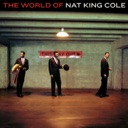Rhythm & Blues
Wesley Prince, Oscar Moore, and Nat King Cole at the Zanzibar, NY, 1946
William P. Gottlieb collection at the Library of CongressKey Attributes of Rhythm & Blues
Select to filter timelineThemes
- Racism/Discrimination
- Dance
- Love/Relationships
- Social Consciousness
- Migration
- Daily Life
- Entertainment
Musical Features
- Syncopation
- Arrangement
- Ensemble
- Blues Form
- Vocals
- Verse/Refrain
- Harmony
- Rhythms
Instruments
- Bass
- Drums
- Guitar
- Organ
- Piano
- Saxophone
- Strings
- Trombone
- Trumpet
“I became the band leader at the Club Alabam [Los Angeles]. I could see the music that was to be named rhythm and blues, taking shape. The blues and jazz elements were coming together.”Johnny Otis
Rhythm and blues is a form of Black dance music that has its origins in the post-World War II era (1939–1945); the term itself is attributed to Jerry Wexler, a writer for Billboard, who coined it in 1949 for the magazine’s Black music chart to replace the term “Race Music” (a term in use since 1920). Rhythm and blues performers encompass hybrid jazz/blues combos, trios, and vocal harmony groups to blues shouters and gospel-inflected solo singers.
Context and History
Rhythm and Blues is a by-product of the World War II migration of southern Blacks to major urban centers in the North and on the East and West Coasts. An estimated five million African Americans abandoned their jobs as sharecroppers, tenant farmers, domestics, and general laborers, anticipating better economic and educational opportunities and an escape from racial oppression. They found high-paying jobs in wartime industries, but discriminatory housing practices led to the growth of segregated urban communities. African Americans established a dynamic entertainment district in every major city where they settled, transforming rural traditions into urban forms of expression. These vibrant styles captured the spirit, pulse, and tempo of the city, and often incorporated new technologies such as electric instruments and amplification.
Combos
Working together in cities, blues singers and jazz musicians created a new musical genre–rhythm and blues. Former swing band members reduced the 12–16-member ensemble to a seven- or eight-piece group consisting of rhythm section, alto and tenor sax, and trumpet. Jazz musician Louis Jordan and His Tympany Five (that featured Jordan on vocals) provided the model for this rhythm and blues combo style heard in “Caldonia” (1945). These combos, popular from the1940s through the early-1950s, retained the boogie-woogie foundation, the shuffle beat, and the riffing horn patterns from swing. Notable instrumental combos include those led by saxophonists Paul Williams, Big Jay McNeely, Harold Singer, and Wild Bill Moore. The rockin’ style of instrumental combos, heard in “The Deacon’s Hop” (1948) by Big Jay McNeely and “We’re Gonna Rock, We’re Gonna Roll” (1948) by Wild Bill Moore established the foundation for “rock ‘n’ roll.” Rhythm and blues combos often featured blues singers such as Wynonie Harris, Mabel Scott, Amos Milburn, and Big Joe Turner, who moaned and shouted the blues in ways that reflected a range of feelings and emotions. The vocals of Etta James, Dinah Washington, Ruth Brown (“Mama He Treats Your Daughter Mean,” 1953) and LaVern Baker often conveyed a gospel flavor.
Trios
Jazz pianist Nat “King” Cole pioneered the trio style, consisting of piano/organ, bass, and guitar. Performed in small clubs and hotel lounges, this music provided a background for conversations, although patrons in African American clubs danced as well. Trios later added drums and other percussion. In addition to Cole, the trio style was popularized by Johnny Moore’s Three Blazers, pianists Charles Brown, Ivory Joe Hunter McDuff, Shirley Scott, Jimmy McGriff, and Richard “Groove” Holmes. Individual trios had signature styles that mirrored their training in jazz, pop and/or blues, as heard in “Straighten Up and Fly Right” (1943) by Nat “King” Cole and “Drifting Blues” (1946) by Johnny Moore’s Three Blazers featuring Charles Brown.
“All the girls liked vocal groups. If you didn’t sing in a vocal group, you didn’t get no girls. The girls used to sit around on the corner and watch these guys sing these love ballads.”Albert “Diz” RussellMember of the Orioles
Vocal Harmony Groups
Vocal harmony groups performed in the 1930s and ’40s with jazz bands and as independent groups. Pioneers like the Mills Brothers (“Paper Doll,” 1942), Delta Rhythm Boys (“Certainly Lord,” 1953), Ink Spots, and the Charioteers featured smooth harmonies based on barbershop, jazz, and sacred music. These groups, as well as the Ravens (“Old Man River,” 1947), established the model for the 1950s teenage a cappella groups that popularized the vocal harmony style on inner city street corners and the stoops of crowded apartment buildings as well as in parks and school gyms. Many of these “bird” groups (e.g., Swallows, Penguins, etc.), sang in a romantic style emulating the Orioles (“It’s Too Soon to Know,” 1948), who began recording in the late 1940s. Although they primarily sang a cappella, producers added sparse instrumentation, including guitar and drums played with brushes, to their commercial recordings. The Spaniels and the Moonglows added a rhythmic foundation to the “romantic” vocal group style. The bass voice imitated the string bass, singing nonsense phrases like “doo-doo-wop.” “Sincerely” (1954) by the Moonglows illustrates this “doo-wop” style—a style later defined as rock ‘n’ roll.
Rhythm and Blues in the Mainstream: Uptown R&B
In the mid-1950s, record labels began producing rhythm and blues music for consumption beyond African American communities (referred to as Uptown R&B). Targeting mainstream audiences, producers applied crossover formulas to the productions of vocal harmony groups. They, for example, replaced rhythm and blues elements with familiar pop production formulas: sing-along refrains replaced call-and-response structures; “pop” vocal harmonies substituted for those associated with the blues and gospel traditions; orchestral arrangements (strings, marimba, tympani, and percussion) replaced rhythm and blues combos; and Latin-flavored rhythms, especially the “cha-cha” beat, substituted for swing rhythms and heavy backbeats on 2 and 4. Examples include “Only You” (1955) by the Platters and “There Goes My Baby” (1959) by the Drifters. Artists also recorded pop standards known as Tin Pan Alley songs written by professional songwriters hired by music publishers beginning in the early 20th century. They wrote ballads, novelty songs, vaudeville and dance songs, among other styles. Some of the most frequently recorded pop standards include “Over the Rainbow,” “Stormy Weather,” “Summertime,” “Georgia On My Mind,” and “At Last.”
Even though rhythm and blues acquired musical elements from pop for mainstream acceptance and marketed under the rock ‘n’ roll label, record labels continued to produce the jazz-blues combo styled rhythm and blues for African American communities. Songs such as Ray Charles’s “Hit the Road Jack” (1962) and “You Don’t Know Me By Now” (1962), Rufus Thomas’s “Walking the Dog” (1963), Ike and Tina Turner’s “You Can’t Miss Nothing That You Never Had” (1964), Etta James’s “Something’s Got a Hold of Me” (1962) and James Brown’s “Prisoner of Love” (1963), remained popular among African Americans, especially in the South. They also continued producing hits that made the Billboard rhythm and blues charts. In the mid-1960s, the combo style transformed into a new sound labeled “soul.”
“We were into young people’s music. We had much younger writers, eighteen to twenty-two years old. Writers are a reflection of the voices of people…. if you have a writer, he is going to write about young love. He can’t write about old love – he’s never experienced it.”Mickey StevensonMotown Songwriter-Producer
The New Sounds of Young America
By the mid-1950s, songwriters in their late-teens and early twenties were writing hit songs that mirrored their youthful experiences and fantasies. All female groups (“girl groups”) joined their male counterparts recording these songs. The Chantels’ “Maybe” (1957), The Shirelles’ “Will You Love Me Tomorrow” (1960), The Crystals’ “He’s a Rebel ” (1962), and The Ronettes’ “Be My Baby” (1963) were among the popular girl groups that inspired the formation of teenage girl groups who later signed with Motown Records. The Miracles’ “Shop Around” (1960), The Marvelettes’ “Please Mr. Postman” (1961), Martha and the Vandellas’ “Heatwave” (1963), The Supremes’ “Where Did Our Love Go” (1964), and their male counterparts, The Temptations’ “The Way You Do the Things You Do” (1964) became the next generation of teenaged groups. They represented Motown’s “Sound of Young America.”
Musical Features/Performance Style
The rhythm and blues combo style is rooted in the blues and jazz traditions. The up-tempo style known as “jump blues” is characterized by a 12-bar blues structure, boogie-woogie bass line, shuffle rhythms (triplet quarter note followed by a triplet eighth note), syncopated horn riffs, solo alto saxophone, and group singing on refrain lines. The lead singers of the first rhythm and blues vocal harmony groups, known as “romantic” groups, sang in a lyrical and smooth style that employed phrasing, shading, and timing techniques closely aligned with those of jubilee quartets. Doo-wop groups added rhythmic movements when the bass voice began imitating the “walking” string bass associated with jazz. The addition of orchestral arrangements, sing-along choruses, and Latin rhythms to rhythm and blues made this sound more compatible with the musical tastes of mainstream American adults. The producers for Motown added these pop production elements over a rhythm and blues foundation and incorporated the lyrics of young professional songwriters to produce the crossover Motown’s “Sound of Young America.”
Lyrics
One branch of rhythm and blues lyrics derive from everyday experiences and relationships of adults; they often satirized daily life, illustrated in song titles such as “What’s the Use of Getting’ Sober (When You Gonna Get Drunk Again)” (1942), “R.M. Blues (1946),” “Old Maid Boogie (1947),” “Good Rockin’ Tonight” (1948), and “Elevator Boogie” (1948). Many of these songs employ double entendre, a linguistic device that masked sexual innuendo. Novelty lyrics are common in rhythm and blues and provided humorous commentaries on everyday events in Black life, as found in “Beans and Cornbread” (1949), “Ain’t Nobody Here but Us Chickens (1946)” and “Saturday Night Fish Fry” (1949). Relationship songs, especially about romance, are common, for example “There Goes My Baby” (1959), “This Magic Moment” (1960), and “All I Could Do Was Cry” (1960).
The other branch of lyrics mirrors the worldviews, experiences, relationships, and fantasies of teenagers. Songs like “Searching” (1957), “Dedicated to the One I Love” (1961), “Do You Love Me” (1963) and “Dancing in the Streets” (1964).
Bibliography
- George, Nelson. The Death of Rhythm and Blues. Penguin Books. 2003.
- Maultsby, Portia K. “Rhythm and Blues/R&B” in Mellonee V. Burnim and Portia K. Maultsby, eds. African American Music: An Introduction. 2nd ed. New York: Routledge Press, 2015, p. 239-276.
- Otis, Johnny. Upside Your Head! Rhythm and Blues on Central Avenue. Hanover, N.H.: Wesleyan University Press. 1993.



























